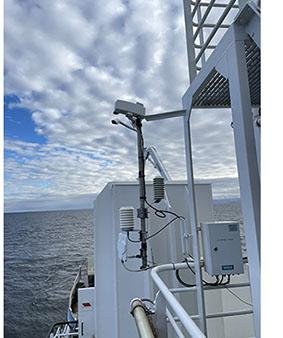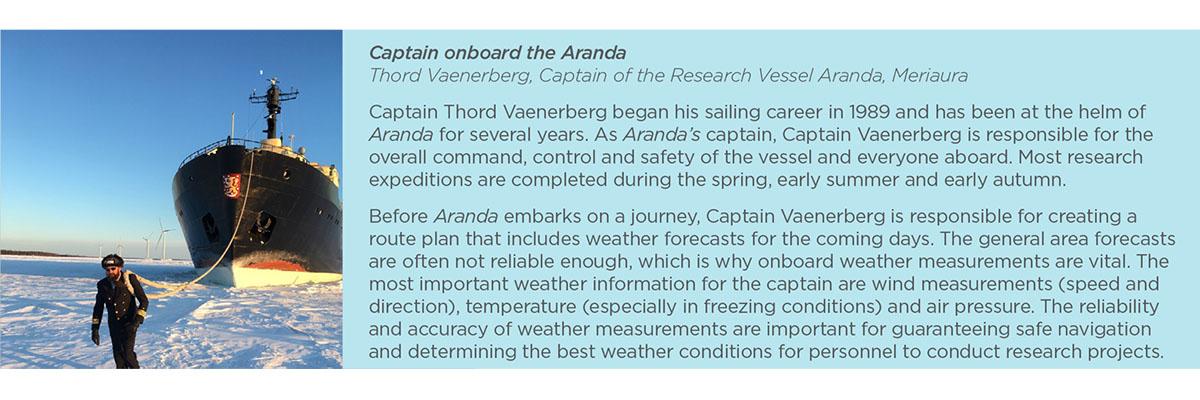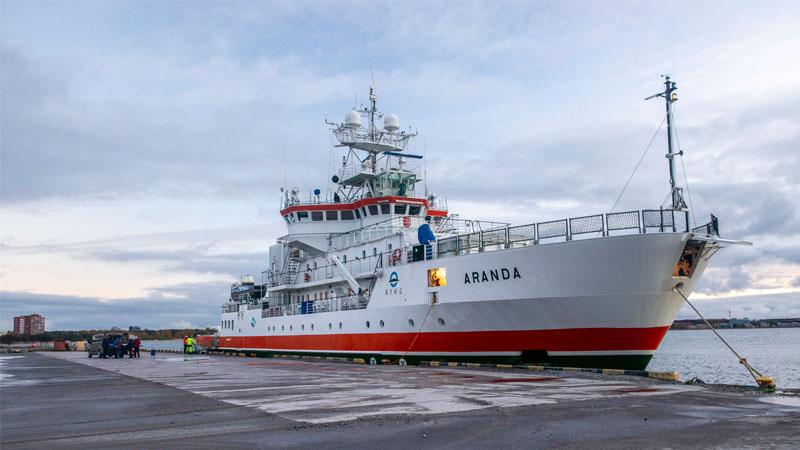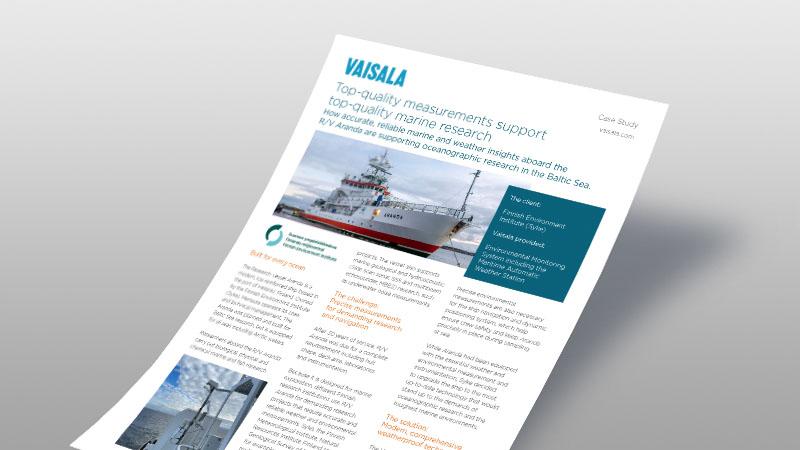Top-quality measurements support top-quality marine research
How accurate, reliable marine and weather insights aboard the R/V Aranda are supporting oceanographic research in the Baltic Sea.

The client: Finnish Environment Institute (Syke)
Vaisala provided: Environmental Monitoring System including the Maritime Automatic Weather Station
Built for every ocean
The Research Vessel Aranda is a modern, ice-reinforced ship based in the port of Helsinki, Finland. Owned by the Finnish Environment Institute (Syke), Meriaura operates its crew and technical management. The Aranda was planned and built for Baltic Sea research, but is equipped for all seas including Arctic waters.
Researchers aboard the R/V Aranda carry out biological, physical and chemical marine and fish research projects. The vessel also supports marine geological and hydroacoustic (Side scan sonar, SSS and multibeam echosounder, MBES) research, such as underwater noise measurements.

The challenge: Precise measurements for demanding research and navigation
After 30 years of service, R/V Aranda was due for a complete refurbishment including hull shape, deck area, laboratories and instrumentation.
Because it is designed for marine exploration, different Finnish research institutions use R/V Aranda for demanding research projects that require accurate and reliable weather and environmental measurements. Syke, the Finnish Meteorological Institute, Natural Resources Institute Finland and Geological Survey of Finland, for example, are conducting multidisciplinary, year-round marine research in the harsh conditions of the Baltic Sea.
Precise environmental measurements are also necessary for the ship navigation and dynamic positioning system, which help ensure crew safety and keep Aranda precisely in place during sampling at sea.
While Aranda had been equipped with the essential weather and environmental measurement and instrumentation, Syke decided to upgrade the ship to the most up-to-date technology that would stand up to the demands of oceanographic research and the toughest marine environments.
The solution: Modern, comprehensive, weatherproof technology
The Vaisala Environmental Monitoring System (EMS) is perfectly suited to Aranda for its high accuracy and reliability in extreme ocean environments. Consisting of the Vaisala Maritime Automatic Weather Station and selected weather instruments and sensors, the EMS supplies readings every minute for wind speed and direction, air pressure, humidity and temperature, solar radiation, seawater temperature and conductivity to support efficient research and safe navigation.
Two Vaisala WINDCAP® WMT700 Ultrasonic Wind Sensors and a Vaisala Wind Set WA15 wind anemometer measure wind direction and wind speed from the slightest breeze to extremely high gusts.
The Vaisala BAROCAP® Digital Barometer PTB330 measures barometric pressure and helps ship operators to track local and regional weather fronts, generate historical models of high- and low-pressure systems, and monitor developing severe weather for an early warning system.
The Vaisala HUMICAP® Humidity and Temperature Probe HMP155 provides humidity and temperature measurement, and the Vaisala Present Weather Detector PWD22 enables characterization of reduced visibility, precipitation type identification, precipitation accumulation and intensity measurement, and report formats.
The ceiling and base height of cloud layers are accurately measured by the Vaisala Ceilometer CL31 which leverages pulsed diode lidar technology and single lens optics, while operators use the accompanying CL-VIEW software for data collection, storage and presentation.
Sea water temperature is measured by the Vaisala DTS12W Water Temperature Probe along with thermosalinograph measurements such as salinity, conductivity and sound velocity. Solar radiation sensors installed on the roof of the bridge measure broadband solar irradiance as well as solar radiation flux density on the vessel — essentially measuring the power of the light and heat from the sun.
All measurement data is collected and displayed in the ship’s navigation system and in a specifically-designed weather application used by onboard researchers. Wind observation data is also visible in the radar display. All weather and environmental data is sent to the Finnish Meteorological Institute for further processing and storage.
The benefits: Safe sailing, efficient marine studies
The Environmental Monitoring System is supporting the researchers and crew on Aranda with accurate and reliable environmental measurements. The dependable data helps them make detailed analyses and studies of the oceanic and atmospheric conditions — in the safest weather conditions — leading to a greater scientific understanding of marine ecosystems.
The advanced environmental measurement technology also gives ship operators confidence, knowing they have highly accurate and reliable data to aid the ship navigation and dynamic positioning system.


